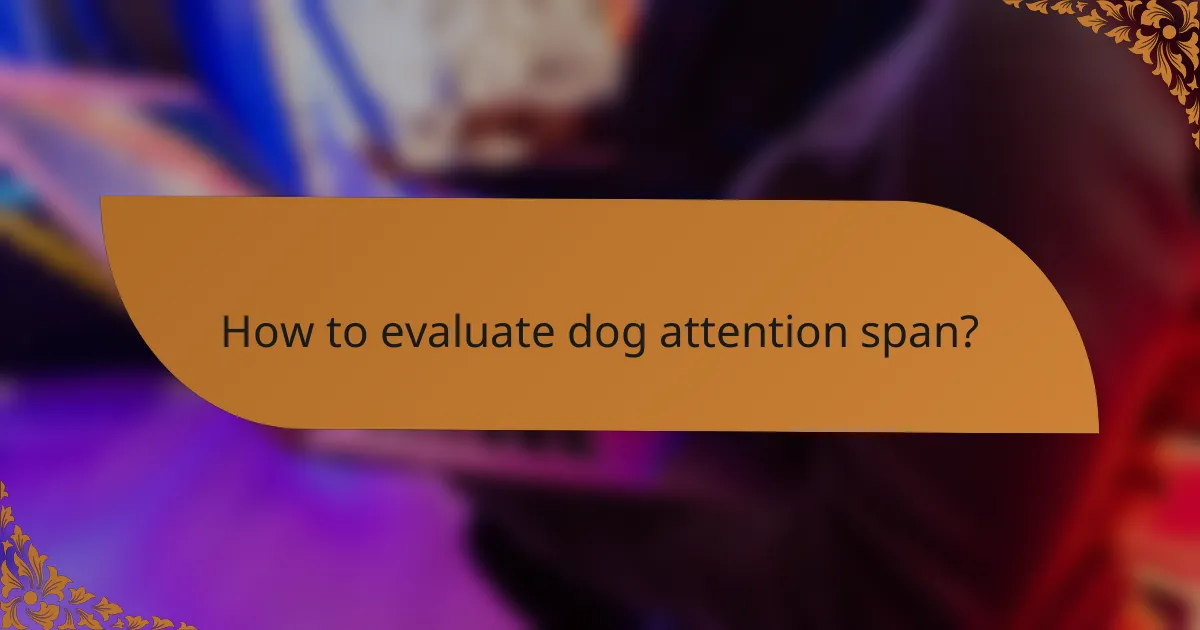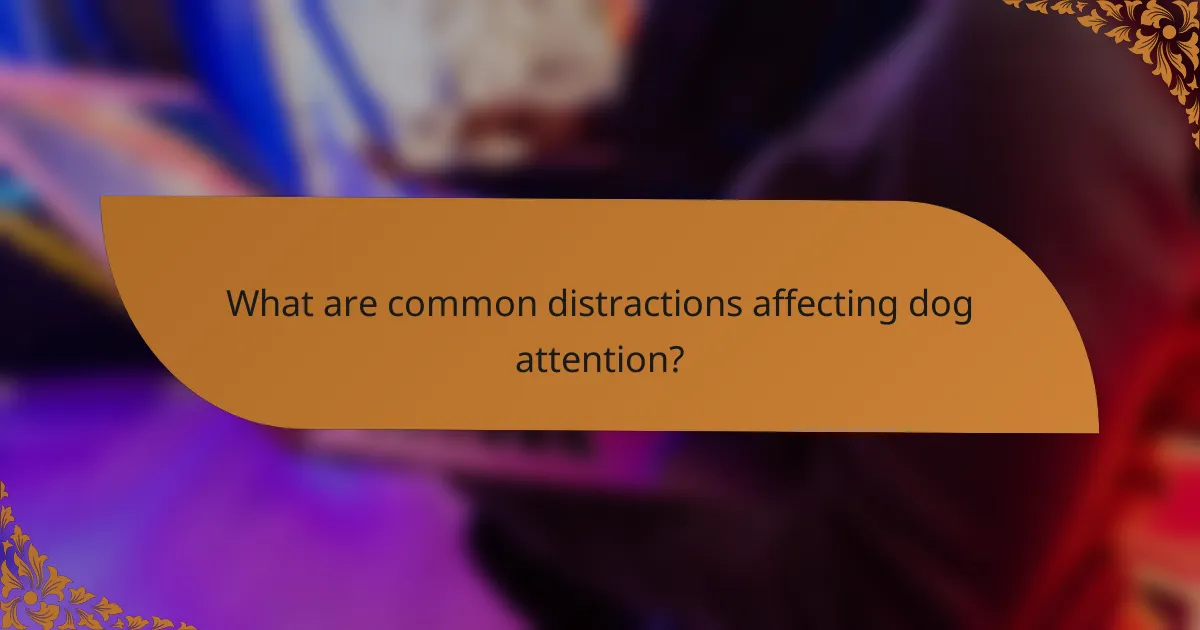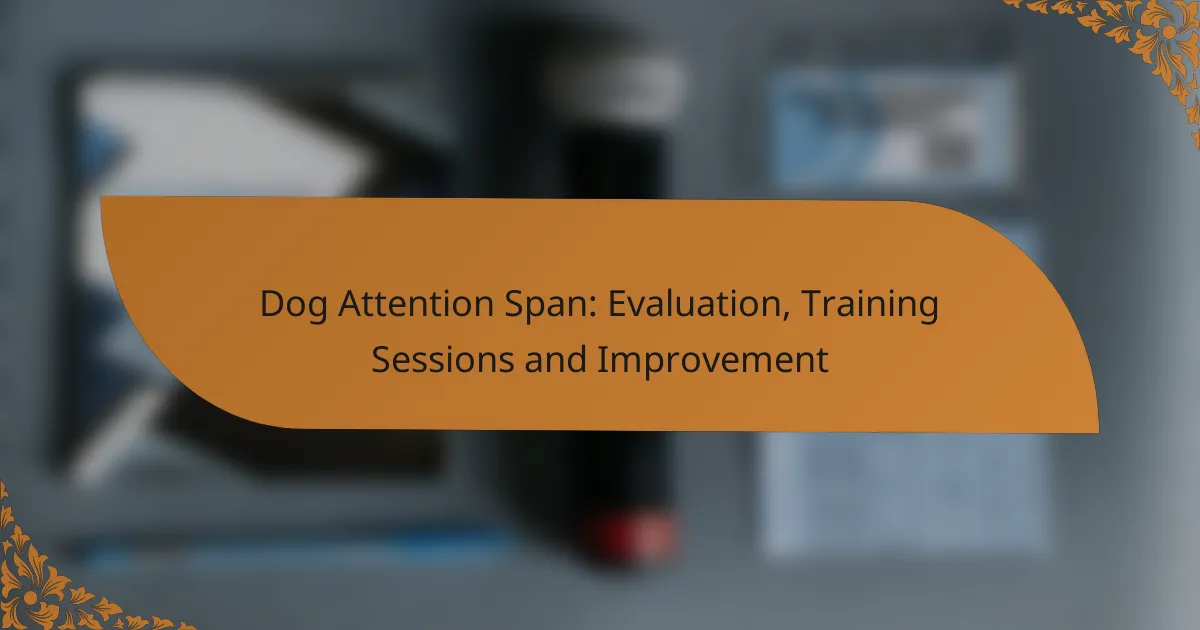Understanding a dog’s attention span is essential for effective training and interaction. By evaluating their focus during various activities, owners can tailor training sessions to be short and engaging, which helps improve concentration. Additionally, recognizing common distractions can aid in creating a conducive environment for learning.

How to evaluate dog attention span?
Evaluating a dog’s attention span involves observing their focus and engagement during various activities. This assessment helps determine how long a dog can concentrate on a task before losing interest, which is crucial for effective training and interaction.
Behavioral observation techniques
Behavioral observation techniques involve watching a dog during training sessions or playtime to assess their attention span. Look for signs of distraction, such as looking away, sniffing the ground, or wandering off. A focused dog will maintain eye contact and respond promptly to commands.
To conduct a simple observation, engage your dog in a task like fetching a toy. Note how long they stay engaged before losing interest. This can help you identify their attention span in a familiar environment.
Standardized attention span tests
Standardized attention span tests provide a structured way to measure a dog’s focus. One common test is the “sit and stay” exercise, where the dog must remain in position while distractions occur. Timing how long they can hold the position without breaking focus offers insights into their attention capabilities.
Another method is the “treat distraction test,” where treats are placed at varying distances, and the dog is asked to stay. Measuring the time taken for the dog to break focus can help gauge their attention span under distraction.
Age-related attention span benchmarks
Age plays a significant role in a dog’s attention span. Puppies typically have shorter attention spans, often lasting only a few minutes, while adult dogs can focus for longer periods, generally ranging from 10 to 20 minutes. Senior dogs may experience a decline in attention span due to cognitive changes.
Understanding these benchmarks can help tailor training sessions to your dog’s age. For instance, shorter, more frequent training sessions are beneficial for puppies, while adults may handle longer sessions with breaks in between.

What training sessions improve dog attention span?
Training sessions that focus on short, engaging activities can significantly enhance a dog’s attention span. By structuring sessions to be brief and interactive, dogs remain more focused and responsive to commands.
Short, focused training intervals
Short training intervals, typically lasting between 5 to 10 minutes, can keep a dog’s attention sharp. Dogs often have limited attention spans, so breaking training into smaller segments helps maintain their interest and reduces frustration.
Consider scheduling multiple short sessions throughout the day rather than one long session. This approach allows for better retention of commands and skills, as dogs are more likely to engage when they know the training will be brief.
Positive reinforcement strategies
Using positive reinforcement, such as treats or praise, encourages dogs to focus during training. When dogs associate good behavior with rewards, they are more likely to pay attention and participate actively.
Implement a system where you reward your dog immediately after they successfully follow a command. This immediate feedback reinforces their learning and keeps them engaged in the training process.
Engagement through interactive toys
Incorporating interactive toys into training sessions can enhance a dog’s attention span by making learning fun. Toys that require problem-solving or physical activity can capture a dog’s interest and keep them mentally stimulated.
Consider using puzzle toys or treat-dispensing devices during training. These tools not only engage your dog but also provide a reward for their efforts, reinforcing their focus and willingness to learn.

What are common distractions affecting dog attention?
Common distractions that affect a dog’s attention include environmental stimuli, competing noises, and the presence of other animals. These factors can significantly impact a dog’s ability to focus during training sessions or daily activities.
Environmental stimuli
Environmental stimuli encompass various elements in a dog’s surroundings, such as moving objects, people, and changes in light or temperature. Dogs are naturally curious and may become easily distracted by these factors, which can divert their attention away from training or tasks.
To minimize distractions from environmental stimuli, consider conducting training sessions in a quiet, familiar space. Gradually introduce distractions as your dog becomes more focused, allowing them to learn how to maintain attention despite external influences.
Competing noises
Competing noises can include sounds from traffic, other animals, or household appliances. These auditory distractions can interfere with a dog’s ability to hear commands or cues, leading to decreased focus during training.
To combat competing noises, try to choose training times when the environment is quieter. If unavoidable noises occur, use positive reinforcement to encourage your dog to remain focused on you, rewarding them for ignoring distractions.
Presence of other animals
The presence of other animals can be a significant distraction for dogs, especially if they are not well-socialized. Dogs may become overly excited or anxious when they see or hear other pets, which can hinder their attention during training sessions.
To improve focus in the presence of other animals, gradually expose your dog to different species in controlled settings. Use treats and praise to reinforce calm behavior, helping your dog learn to stay focused on you despite the distractions around them.

How does breed influence attention span?
Breed significantly affects a dog’s attention span, with working breeds typically exhibiting longer focus periods compared to companion breeds. This difference is often rooted in the original purposes of these breeds, such as herding or guarding, which require sustained concentration and responsiveness.
Working breeds vs. companion breeds
Working breeds, such as Border Collies and German Shepherds, are bred for tasks that demand high levels of focus and mental engagement. These dogs can often maintain attention for extended periods, sometimes exceeding 15-20 minutes during training sessions.
In contrast, companion breeds like Pugs and Shih Tzus may have shorter attention spans, often ranging from 5-10 minutes. Their training sessions should be more frequent but shorter to keep them engaged and prevent boredom.
Specific breed attention span studies
Research indicates that breeds like the Labrador Retriever and Golden Retriever show moderate attention spans, often performing well in obedience training. Studies suggest that these breeds can focus for about 10-15 minutes before needing a break.
On the other hand, studies on smaller breeds, such as Chihuahuas, reveal that they may struggle with longer training sessions, typically focusing for only 5-7 minutes. Understanding these differences can help owners tailor their training approaches to match their dog’s breed characteristics.

What role does age play in dog attention span?
Age significantly influences a dog’s attention span, with younger dogs generally exhibiting shorter focus periods compared to older dogs. Puppies are often easily distracted, while senior dogs may have varying attention spans due to cognitive changes.
Puppy attention span characteristics
Puppies typically have an attention span that lasts only a few minutes, often ranging from 5 to 10 minutes during training sessions. Their natural curiosity and energy can lead to frequent distractions, making it essential to keep training sessions short and engaging.
To effectively train a puppy, use positive reinforcement techniques and incorporate play into learning. This approach helps maintain their interest and encourages them to focus on tasks for longer periods.
Senior dog attention span changes
As dogs age, their attention span can change due to factors like cognitive decline or health issues. Senior dogs may have a longer attention span than puppies, but they can also experience lapses in focus due to distractions or fatigue.
When training senior dogs, it’s important to adjust the duration and intensity of sessions. Aim for shorter, more frequent training intervals, and be patient, as older dogs may require more time to process commands and cues.

How can owners create a distraction-free training environment?
Creating a distraction-free training environment is essential for effective dog training. This involves minimizing external stimuli that could divert your dog’s attention away from the training session.
Choose a quiet location
Select a training area that is free from noise and interruptions. Ideal spots include a quiet room in your home or a secluded outdoor area. Avoid places with high foot traffic or loud sounds, as these can easily distract your dog.
Limit visual distractions
Visual stimuli can also disrupt your dog’s focus. Ensure the training space is free from distractions like other pets, moving vehicles, or people. Using barriers, such as gates or screens, can help block out these distractions during training sessions.
Use appropriate timing
Timing your training sessions can significantly impact your dog’s attention span. Schedule training when your dog is naturally alert, such as after a walk or playtime. Avoid training during times when your dog is likely to be tired or overly excited.
Keep sessions short and engaging
Short, engaging training sessions are more effective than lengthy ones. Aim for sessions lasting around 5 to 10 minutes, especially for younger dogs. Incorporate fun activities and rewards to maintain your dog’s interest and motivation throughout the training process.
